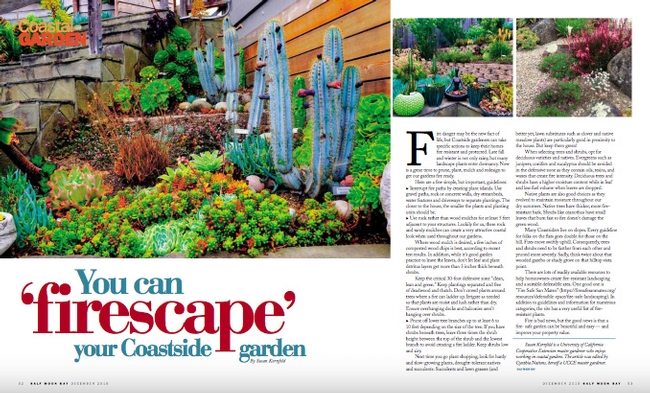- Author: Arwen Griffith
- Editor: Susan Kornfeld
- Editor: Cynthia Nations
I grew up on the East Coast, so for me, spring means snowdrops followed by crocuses and then buttercups. When I moved to California, spring just wasn't the same. But as I grew more interested in gardening, I started noticing the little native gems that popped up in February as well as the fields turning riotously yellow or purple with wild mustard and radish.
Last spring, California had a "super bloom," where complex conditions cause long-dormant seeds to bloom all at once. Hillsides all over the state were blanketed in color. But while super blooms are primarily a desert phenomenon, wet springs can deliver spectacular flower shows anywhere.
There's no super bloom on the horizon this year, though, as this February had the lowest rainfall on record. But although spring is clearly shaping up to be warm and dry, it doesn't mean you won't be able to see the Bay Area's exquisite wildflowers. I'm already seeing the first California poppies, and by the time this article is out, they should be in full swing along with many other delightful wildflowers. Here are just a few other varieties to look for:
- Blue-eyed grass (Sisyrinchium bellum) – it's not a grass at all, but a member of the iris family, its low purple flowers reward those with patience. The yellow throats lure in pollinators.
- Blue dicks (Dichelostemma capitatum) have bell-like flowers on a tall stalk. They can get lost in taller grasses but flash into sight with the wind.
- Cream cups (Platystemon californicus) look a little like buttercups; these pretty cream and yellow flowers are found in disturbed soil and open areas.
- Lupines (Lupinus bicolor and others) are hardy natives, usually purple or blue, that thrive in disturbed areas. Dense-flowered platycarpos (L.microcarpus) is a compact lupine with yellow or cream flowers. There are more than 70 varieties of native lupine in California!
- Goosefoot violet (Viola purpurea) has cheery yellow flowers and pops up even on the rocky cliff edge in Bernal. I may have been spotted crawling out to photograph it. A similar flower is Shelton's violet (viola sheltonii), which grows in wooded areas.
- Leopard lily (Lilium pardilinum) is my personal favorite, although I have only seen it growing wild on Mt. Tamalpais. It likes wet feet and has spectacular reddish orange flowers hanging in clusters along a stem that can reach 8 feet tall.
- Northwest crimson columbine (Aquilegia formosa) is a stunning find, typically in moist areas. It's sometimes called crowsfoot because of the shape of the leaves.
- Shooting star (Deodecatheon clevelandii) is a delicate native relative of the cyclamen. With tiny purple flowers, it's easy to miss, but worth seeking out.
- Yarrow (Achillea millefolium) is often seen in either yellow or white varieties. It's a medicinal herb as well as being hardy and drought-tolerant.
- Serrated onion (Allium serra) has a pretty pale pink flower on a 12-16 inch stalk. It has a few hollow leaves at the base that smell like, well, onion. It can be mistaken for Thrift, which is usually on the coast, and has flowers clustered in fives rather than three or six like the allium.
- Wild radish (Raphanus sativus) is not native; it's naturalized from Europe, but covers fields and roadsides all over the state. It is always purple or pink; the almost identical flowers you see in white or yellow are jointed charlock (R. raphinistrum) or a hybrid of the two. While cultivated radish has an edible root, you'll want to try the seedpod of this one.
For learning more, I highly recommend Introduction to California Spring Wildflowers, by Philip Munz (2004, UC Press).
Arwen Griffith is a UC Master Gardener living in San Francisco who enjoys the wildflowers on our northern California coast. Contact your local Master Gardeners for free gardening advice at http://smsf-mastergardeners.ucanr.edu or on Facebook or Instagram @sfbaygardeners. The article was edited by Susan Kornfeld and Cynthia Nations, UC Master Gardeners.
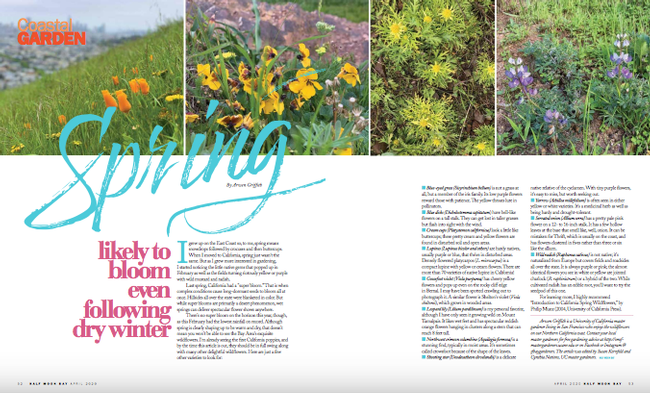
- Author: Susan Kornfeld
- Editor: Cynthia Nations
This South African invader has charm. Its lemon-yellow flowers nodding over emerald leaves make a lush foreground to the gray-blues of the Pacific. But any pleasure has long since changed to chagrin as carpets of Buttercup Oxalis began smothering our coastal native plants and infesting our neighborhoods.
Sadly, the weed is so entrenched along the California coast that physically removing it from the wild just isn't feasible anymore. It doesn't spread by seeds, but rather through small bulbils that develop on the stem beneath the leaves and by new bulbs that form underground along the rhizome. Each plant produces around twelve bulbils, so each year the buttercup crop significantly expands.
But take heart, home gardeners! With good timing, a bit of technique, and vigilance – especially vigilance – it's possible to reduce Oxalis to manageable quantities within a few years.
One technique, if you have limited numbers of the weed, is to pull the plants gently out when they are big and lush but not yet in bloom. This is when the adult bulb is spent, and the bulbils are not yet fully developed. If you pull too early or too late, you will almost certainly leave a lot of viable bulbs and bulbils in the soil. Pulling is easiest in soft soil, so add plenty of organic material throughout the year to keep it conditioned.
A second technique, useful for larger infestations, is to exhaust the plants. Pull them up or sever their foliage repeatedly throughout the growing season until their bulbs are starved. Sever by mowing or by using a scuffle hoe or other scraping tool. Keep at it because, until the plants run out of energy, they can regrow from shoots and bulb.
Also of importance: Compost piles may not get hot enough, so bag up weeded plants and bulbs and put them in the garbage. Don't relocate or dispose of any soil where buttercup oxalis has grown as it is likely to be full of bulbs.
Tarping affected areas can be effective, but is often impractical in home gardens. Black plastic or shade cloth should be pinned over the affected area and left for at least six months.
As for herbicides, at least two recent research studies, one on a Mediterranean island and one in the Bodega Bay coastal area have found glyphosate fairly effective. The former study used a 3% concentration and the latter only .13%. Glyphosate trials showed both significant Oxalis reduction and rebound of native plants.
Whether or not glyphosate is a good option for home gardens depends on the type and severity of the infestation as well as home owner preference. Herbicides are often not practical, and to many, undesirable, in the home garden, especially as a first approach to removing invasives. Unfortunately, there are no biocontrol agents available for buttercup oxalis at this time. Klugeana Philoxalis, a moth larva from South Africa that feeds on it, won't be available in the U.S. for years, if at all.
In the meantime, battle the buttercups. They may seem overwhelming, but consider this: they are easier to remove, nicer to look at, and more pleasant to handle than the thistles and burs that otherwise plague us.
Susan Kornfeld gardens professionally in San Mateo County. She is a UC Master Gardener and can be found at the Plant Clinic at the San Mateo Arboretum the first Sunday of most months. The article was edited by Cynthia Nations, UC Master Gardener
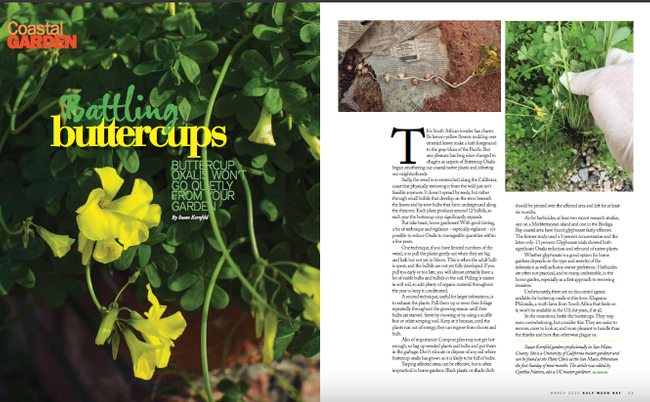
- Author: Cynthia Nations
- Editor: Janice Moody
Blueberries are to be savored. The dark azure or pink (on new cultivars) skin is firm, and the flesh is a delicate membrane that is sometimes tart and sometimes sweet depending on the variety. Before the 1900s, people enjoyed these North American natives in the wild. Then scientists began to cultivate blueberries for the blueberry industry and home gardens. At present, large and luscious juicy berries are easy to grow in your garden, and the bushes (relatives of the genus Rhododendron) have a high resistant to diseases and pests.
There are 3 types of blueberries: highbush, lowbush, and a hybrid half-high. The best species for coastal climates is the northern and southern highbush with chill hours
Identifying your climatic conditions is essential when selecting blueberry plants. The northern coastal region of California has been identified as climate zone C (Sunset Zone 17) and includes Half Moon Bay, Pacifica, and parts of San Francisco. Winds and coastal fog dominate much of this zone in moderate summers and winters; therefore, low chill varieties should be considered depending on your microclimate factors. Low chill varieties include: Vaccinium corymbosum ‘Gulfcoast,' Vaccinium corymbosum ‘Jubilee,' Vaccinium virgatum ‘Misty,' Vaccinium corymbosum ‘Sharpblue,' and Vaccinium corymbosum ‘Sunshine Blue.'
There is another cultivar of blueberries that grows well in our coastal climate called Rabbiteyes (Vaccinium ashei). Rabbiteyes are native to the southeastern United States. The sweet berries are pink before they turn blue. Rabbiteyes can grow up to 20 feet if unchecked and need to be pruned after a few years of growth. Species of Rabbiteyes include: Vaccinium ‘Pink Lemonade,' Vaccinium ‘Brightwell,' and Vaccinium ‘Austin.'
Blueberries thrive in acidic soil in which the pH is ideally between 4 and 5. The bushes are shallow-rooted; therefore, it requires a soil that holds moisture but also drains well and doesn't stay wet. Mix organic matter into the soil before you plant your bushes. Blueberry bushes that are 1 to 3 years old should be planted as early in the spring as possible. Dig the hole approximately twice as wide and twice as deep as the roots of the plant. If you are planting in the ground, be sure to check the width of the species you purchase and space accordingly. Spread the roots, set the bush, and pack the hole with soil.
A month after planting, apply an organic fertilizer of your choice: blood or fish meal to provide nitrogen, sphagnum peat or coffee grounds to provide acidity, and bone or kelp meal to provide potassium and phosphorus. Apply in a band around the plant 6-12 inches from the crown. Mulch with a 2-4 inch layer of woodchips, sawdust, or pine needles to keep the shallow roots moist. Keep the bushes watered weekly. After a year, continue to apply the same nutrients for mature bushes. During the first year after planting, don't allow the bush to produce fruit by pinching back blossoms developing on newly set plants to allow growth.
During the first 4 years, there is no need to prune your blueberry bush. After the initial 4 years, late winter or early spring pruning is needed to stimulate growth of new shoots that will bear fruit the next season. Cut the spindly, broken, or dead shoots before new growth begins. Remove old wood or low-growing branches where the fruit might touch the ground. Be aware of pests and diseases like birds, blueberry maggot, or powdery mildew. A good source to address pest issues is: https://www2.ipm.ucanr.edu/agriculture/blueberry/
When harvesting, don't be in a hurry to pick the berries as soon as they turn blue. Wait a couple of days when they easily fall into your hand. Blueberries have many health benefits. They contain many antioxidant-rich phytonutrients, and one flavonoid in particular, anthocyanin, is thought to be responsible for much of their beneficial health effects. In addition, the tasty berries are an excellent source of vitamins K and C, manganese, and fiber. Savor and enjoy!
Cynthia Nations is a UCCE Master Gardener who enjoys growing blueberries in large containers in her garden in El Granada. The article was edited by UCCE Master Gardener, Janice Moody.
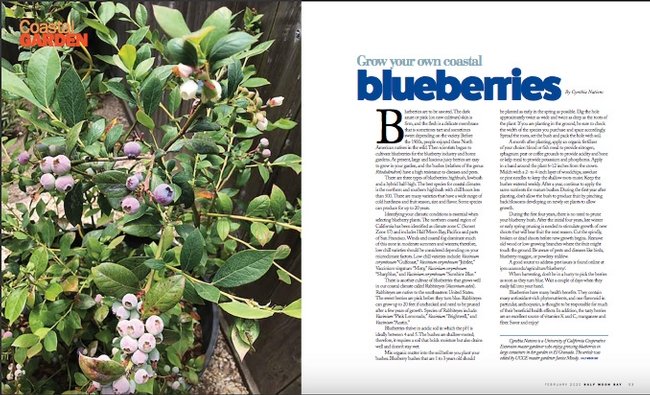
- Author: Cynthia Nations
- Editor: Kim Nations
- Editor: Susan Kornfield
- Photographer: Janice Moody
While sitting in my garden after a recent rain, I became deeply aware of its beauty, sounds, fragrances, and textures. I realized with a sudden clarity how the garden encompasses birth, growth, death, and regeneration.This sensual and meditative experience reminded me of various sensory gardens I've visited in the Bay Area.
Originally designed primarily for educational and recreational opportunities for children and people with special needs, today such gardens are found in both private and public settings for all to enjoy. They awaken all of our senses – not just our visual appreciation of beauty. We admire the harmony and contrasts of colors, the diversity of textures, and the sweet fragrances of flowers.
Gardeners can adopt the same techniques as the designers of these delightful gardens. For stunning visual interest, select plants that bush out, climb, trail, creep, and stand upright. Look for plants with varying bloom sizes, leaf patterns, and stem colors. Make sure to smell both foliage and flowers when shopping to find an appealing mix of aromas. Look for California natives because they are generally low maintenance and less susceptible to disease than non-natives.
The UC Davis Arboretum All-Star Plant Database is a great resource for finding the perfect plants for your microclimate. Some of the visual beauties include Achillea millefolium ‘Island Pink yarrow'-- pink flowers from spring to fall; Arbutus ‘Marina' (Marina madrone)--smooth copper bark, shiny evergreen leaves, and drooping clusters of pink flowers followed by red berries; Calamagrostis x acutiflora ‘Karl Foerster' (a feather reed grass)--upright dark green foliage and fluffy blooms; and Trichostema lanatum (Woolly Blue Curls)--dark purple and ever-blooming. For fragrance, consider the minty Salvia apathacea (Hummingbird sage) and Monardella villosa (Coyote Mint); yarrows for their aromatic, fern-like leaves; and Acacia boormanii (Snowy River wattle) for its fragrant yellow flowers in winter.
Wind whistling through trees, crunching leaves and gravel, birdsong, and chimes are just a few enchanting sounds we can incorporate in our gardens. Encourage the birds and bees by planting nectar-producing plants and providing birdbaths and shallow water dishes. Fountains and wind chimes create lovely sounds to stimulate our senses. To capture the buzzing of bees, consider adding Ceanothus 'Ray Hartman' for early spring bees; Eschscholzia californica (California poppy) for the sweat bees who cover themselves with its pollen; and Lavandula x ginginsii ‘Goodwin Creek Grey' lavender to provide carpenter and other bees with abundant nectar.
To ensure a variety of textures to delight our sense of touch, look for unusual tree bark; furry, velvety, or feathery leaves; and both hard and soft foliage. Walkways and paths can include crushed gravel, smooth tiles, and rough bark. Think about light and temperature contrast, too: having both shady nooks and sunny areas creates very different moods and experiences within the garden.
Don't forget taste! Planting herbs, spices, fruits, and vegetables will add an epicurean dimension. If space is limited, you can plant herbs outside a kitchen window and use containers to grow vegetables and fruit trees. Violets and nasturtiums are cheerful and tasty options for salads and desserts.
Paradise is often conceived of as a garden full of beauty, scents, sounds, and textures. It is easy in such an oasis of pleasure to both create peace and stimulate your mind and senses. You can also exercise your body in creating your own sensory garden.
Cynthia Nations is a UCCE Master Gardener who enjoys her garden in Half Moon Bay, CA. The article was edited by UCCE Master Gardener, Susan Kornfeld and Kim Nations, and the photographs were taken by Janice Moody, UCCE Master Gardener and owner of Seascape Succulents in Half Moon Bay.
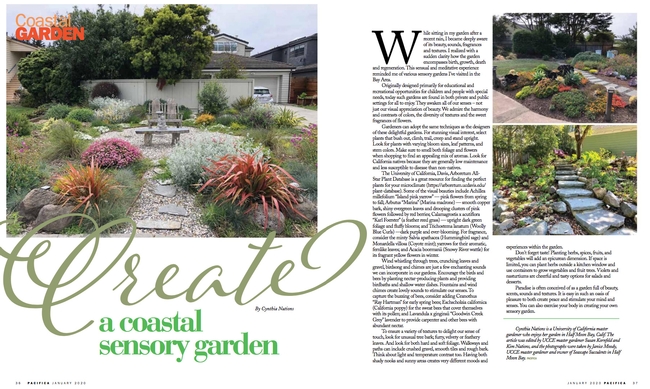
- Author: Susan Kornfeld
- Editor: Cynthia Nations
Fire danger may be the new fact of life, but coast side gardeners can take specific actions to keep their homes fire resistant and protected. Late fall and winter is not only rainy, but many landscape plants enter dormancy; therefore, now is a great time to prune, plant, mulch, and redesign to get our gardens fire ready.
Here are a few simple, but important, guidelines:
-
Interrupt fire paths by creating plant islands. Use gravel paths, rock or concrete walls, dry streambeds, water features, and driveways to separate plantings. The closer to the house, the smaller the plants and planting units should be.
-
Use rock rather than wood mulches for at least five feet adjacent to your structures. Luckily for us, these rock and sandy mulches can create a very attractive coastal look when used throughout our gardens.
-
Where wood mulch is desired, a few inches of composted wood chips are best according to recent test results. In addition, while it's good garden practice to leave the leaves, don't let leaf and plant detritus layers get more than three inches thick beneath shrubs.
-
Keep the critical 30-foot defensive zone "clean, lean, and green." Keep plantings separated and free of deadwood and thatch. Don't crowd plants around trees where a fire can ladder up. Irrigate as needed so that plants are moist and lush rather than dry. Ensure overhanging decks and balconies aren't hanging over shrubs.
-
Prune off lower tree branches up to at least six to ten feet depending on the size of the tree. If you have shrubs beneath trees, leave three times the shrub height between the top of the shrub and the lowest branch to avoid creating a fire ladder. Keep shrubs low and airy.
-
Next time you go plant shopping, look for hardy and slow-growing plants, drought-tolerant natives, and succulents. Succulents and lawn grasses (and better yet, lawn substitutes such as clover and native meadow plants) are particularly good in proximity to the house. But keep them green!
When selecting trees and shrubs, opt for deciduous varieties and natives. Evergreens such as junipers, conifers, and eucalyptus should be avoided in the defensive zone as they contain oils, resins, and waxes that create fire intensity. Deciduous trees and shrubs have a higher moisture content while in leaf and less fuel volume when leaves are dropped.
Native plants are also good choices as they evolved to maintain moisture throughout our dry summers. Native trees have thicker, more fire-resistant bark. Shrubs like Ceanothus have small leaves that burn fast so fire doesn't damage the green wood.
Many Coastsiders live on slopes. Every guideline for folks on the flats goes double for those on the hill. Fires move swiftly uphill. Consequently, trees and shrubs need to be farther from each other and pruned more severely. Sadly, think
twice about that wooded gazebo or shady grove on that hilltop vista point.
There are lots of ready available resources to help homeowners create fire-resistant landscaping and a suitable defensible area. One good one is "Fire Safe San Mateo". In addition to guidelines and information for numerous categories, the site has a very useful list of fire resistant plants.
Fire is bad news, but the good news is that a fire safe garden can be beautiful and easy – and improve your property value.
Susan Kornfeld is a UCCE Master Gardeners who enjoys working in coastal gardens. The article was edited by Cynthia Nations, UCCE Master Gardener.
